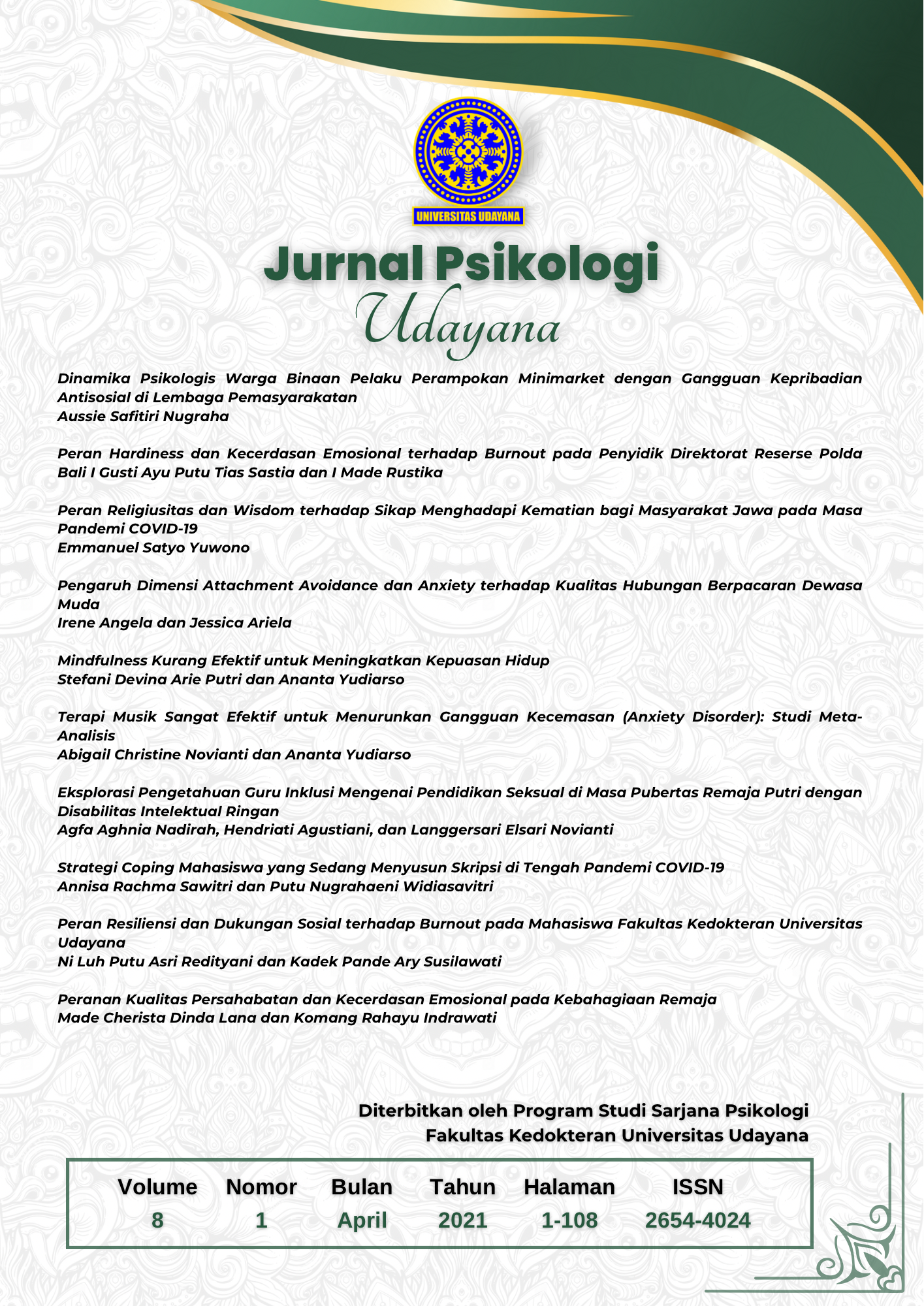Pengaruh dimensi attachment avoidance dan anxiety terhadap kualitas hubungan berpacaran dewasa muda
Abstract
Dating relationship is a crucial part of the human life particularly for the young adults that it can affect the mental health of a person. Hence, the quality of dating relationship should be thoroughly considered because bad dating relationship could contribute negatively to a person’s life, to the person’s relationship with other people in the future and further to the next phase of dating relationship (marriage). Prior researches show that attachment is the preeminent indicators of the quality of relationship. Attachment is human desire to establish relationship based on shared affection with other individuals. Attachment also determines the direction and the basic understanding of individual toward that relationship. The objective of this research is to discern the dimension effect of attachment toward the quality of dating relationship for the young adults. Total participant of this research is 145 people. This research uses quantitative research method with measuring instrument of ‘The Experiences Close Relationship-Revised dan The Perceived Relationship Quality Component.’ The result of this research shows that there is dimension effect of attachment toward the quality of dating relationship by 44,8%. However, attachment avoidance give bigger impact towards relationship quality compare with attachment anxiety.
Downloads
References
Bartholomew, K., & Horowitz, L. M. (1991). Attachment styles among young adults: A test of a four-category model. Journal of Personality and Social Psychology, 61, 226-244.
Brennan, K. A., Clark, C. L., & Shaver, P. R. (1998). Self-report measurement of adult attachment: An integrative overview. In J. A. Simpson & W. S. Rholes (Eds.), Attachment theory and close relationships (pp. 46-76). NY: Guilford Press.
Chen, S. (2015). A latent profile analysis of romantic relationship quality and its associations with personality, partner support, and psychological well-being. Electronic Thesis and Dissertation Repository. Paper 2977.
Chopik, W. J., Edelstein, R. S., & Fraley, R. C. (2013). From the cradle to the grave: Age differences in attachment from early adulthood to old age. Journal of personality, 81(2), 171-183.
Demir, M. (2008). Sweetheart, you really make me happy: Romantic relationship quality and personality as predictors of happiness among emerging adults. J Happiness Stud, 9, 257-277. doi: 10.1007/s10902-007-9051-8.
Domingue, R., & Mollen, D. (2009). Attachment and conflict communication in adult romantic relationships. Journal of Social and Personal Relationships, 26(5), 678-696. doi:10.1177/0265407509347932.
Dush, C. M. K., & Amato, P. R. (2005). Consequences of relationship status and quality for subjective well-being. Journal of Social and Personal Relationships, 22(5), 607-627.
Elizabeth, & Ariela, J. (2020). Forecasting relationship quality of Indonesian newlywed individuals: a quantitative study on the role of attachment. Asia Pacific Journal of Counselling and Psychotherapy, 1-13. https://doi.org/10.1080/21507686.2020.1781668
Farooqi, S. R. (2014). The construct of relationship quality. Journal of Relationships Research, 5, 1–11.
Fletcher, G. J. O., Simpson, J. A., & Thomas, G. (2000). The measurement of perceived relationship quality components: A confirmatory factor analytic approach. Personality and Social Psychology Bulletin, 26, 340-354.
Fraley, R. C. (2010). A brief overview of adult attachment theory and research. IL University of Illinois. Retrieved from http://labs.psychology.illinois.edu/~rcfraley/attachment.htm
Fraley, R. C., & Shaver, P. R. (2000). Adult romantic attachment: Theoretical Developments, emerging controversies, and unanswered questions. Review of General Psychology, 4(2), 132-154. doi:10.1O37//1089-2680.4.2.132.
Fraley, R. C., Waller, N. G., & Brennan, K. A. (2000). An item response theory analysis of selfreport measures of adult attachment. Journal of Personality and Social Psychology, 78, 350–365.
Gere, J., & Schimmack, U. (2013). When romantic partners’ goals conflict: Effects on relationship quality and subjective well-being. J Happiness Stud (14), 37-49.
Harris, V. W. (2013). Healthy Dating Leads to Healthy Marriage. National Resource Center for Healthy Marriage and Families. Retrieved from https://www.researchgate.net/publication/260408504
Hayes, A. F. (2018). Introduction to mediation, moderation, and conditional process analysis (2nd ed.). NY: The Guilford Press.
Hazan, C., & Shaver, P. R. (1987). Romantic love conceptualized as an attachment process. Journal of Personality and Social Psychology, 52, 511-524. .
Hernandez, J. M. C., & Santos, C. C. (2010). Development-based trust: Proposing and validating a new trust measurement model for buyer-seller relationships. Brazilian Administration Review, 7(2), 172-197.
Hidayat, A. (2013). Tabel durbin watson dan cara membaca. Statiskian. Retrieved from https://www.statistikian.com/2013/03/durbin-watson-tabel.html
Indrawati, F., Sani, R., & Ariela, J. (2018). Hubungan antara harapan dan kualitas hubungan pada dewasa muda yang sedang menjalani hubungan pacaran. Jurnal Psikologi Ulayat, 5(1), 72-85.
Kholidah, E. N., & Alsa, A. (2012). Berpikir positif untuk menurunkan stres psikologis. Jurnal Psikologi, 39(1), 67-75.
Laporan LBH: tidak semua perempuan korban kekerasan memilih jalur hokum. (2017). VOA Indonesia. Retrieved from https://www.voaindonesia.com/a/tidak-semua-perempuan-korban-kekerasan-memilih-jalur-hukum/3686162.html
Lembar Fakta dan Poin Kunci Catatan Tahunan (CATAHU) Komnas Perempuan Tahun 2018. (2018). Retrieved from https://www.komnasperempuan.go.id/reads-lembar-fakta-dan-poin-kunci-catatan-tahunan-catahu-komnas-perempuan-tahun-2018.
Li, T., & Chan, D. K. (2012). How anxious nd avoidant attachment affect romantic relationship quality differently: A meta-analytic review. European Journal of Psychology, 42(4), 406-419.
Lund, M. (1985). The development of investment and commitment scales for predicting continuity personal relationships. Journal of Social and Personal Relationships, 2, 3–23.
Luo, S. (2009). Partner selection and relationship satisfaction in early dating couples: The role of couple similarity. Personality and individual differences, 47(2), 133-138.
Miller. (2015). Intimate relationship 7th ed. New York : Mc Graw Hill
Mikulincer, M., & Goodman, G. S. (Eds.). (2006). Dynamics of romantic love: Attachment, caregiving, and sex. Guilford Press.
Mikulincer, M., & Shaver, P. R. (2007). Attachment in adulthood: structure, dynamics, and change. New York: The Guilford Press.
Modus pelaku kekerasan saat berpacaran, ancam sebarkan video intim ke keluarga. (2018). Bangkapos.com. Retrieved from http://bangka.tribunnews.com/2018/03/01/modus-pelaku-kekerasan-saat-berpacaran-ancam-sebarkan-foto-video-intim-ke-keluarga
Noftle, E. E., & Shaver, P. R. (2006). Attachment dimensions and the Big Five personality traits: Associations and comparative ability to predict relationship quality. Joumal of Research in Personality, 40, 179-208. doi: 10.1016/j.jrp.2004.11.003.
Page-Gould, E. (2004). Research on cross-race relationships: An annotated bibliography. Greater Science Center at UC Berkeley. Retrieved from https://greatergood.berkeley.edu/article/item/cross-race_relationships_an_annotated_bibliography
Piedmont, R. L. (2014). Inter-item Correlations. In A. C. Michalos (Ed.), Encyclopedia of Quality of Life and Well-Being Research (pp. 3303-3304). Dordrecht: Springer.
Pinquart, M. F., & Feubner, C. C., Ahnert, L. (2013). Meta-analytic evidence for stability in attachments from infancy to early adulthood. Attachment & Human Development, 15(2), 189-218.
Rhoades, G. K., Kamp Dush, C. M., Atkins, D. C., Stanley, S. M., & Markman, H. J. (2011). Breaking up is hard to do: The impact of unmarried relationship dissolution on mental health and life satisfaction. J Fam Psychol, 25(3), 366-374. 110.
Rubin, Z. (1970). Measurement of romantic love. Journal of Personality and Social Psychology, 16, 265-273.
Schindler, I., Fagundes, C. P., & Murdock, K. W. (2010). Predictors of romantic relationship formation: Attachment style, prior relationships, and dating goals. Personal Relationships, 17(1), 97-105. doi:10.1111/j.1475-6811.2010.01255.x
Shaver, P. R., & Hazan, C. (1988). A biased overview of the study of love. Journal of Social and Personal Relationships, 5(4), 473-501. doi:10.1177/0265407588054005.
Sugiyono. (2017). Metode penelitian kuantitatif, kualitatif, dan kombinasi (mixed methods). Bandung: Alfabeta
Viejo, C., Monks, C. P., Sanchez, V., & Ortega-Ruiz, R. (2016). Physical dating violence in Spain and the United Kingdom and the importance of relationship quality. Journal of interpersonal violence, 31(8), 1453-1475.

This work is licensed under a Creative Commons Attribution-ShareAlike 4.0 International License.
Authors who publish with this journal agree to the following terms:
- Authors retain copyright and grant the journal right of first publication with the work simultaneously licensed under a Creative Commons Attribution-ShareAlike 4.0 International License that allows others to share the work with an acknowledgement of the works authorship and initial publication in this journal.
- Authors are able to enter into separate, additional contractual arrangements for the non-exclusive distribution of the journals published version of the work (e.g., post it to an institutional repository or publish it in a book), with an acknowledgement of its initial publication in this journal.
- Authors are permitted and encouraged to post their work online (e.g., in institutional repositories or on their website) prior to and during the submission process, as it can lead to productive exchanges, as well as earlier and greater citation of published work (See The Effect of Open Access).













